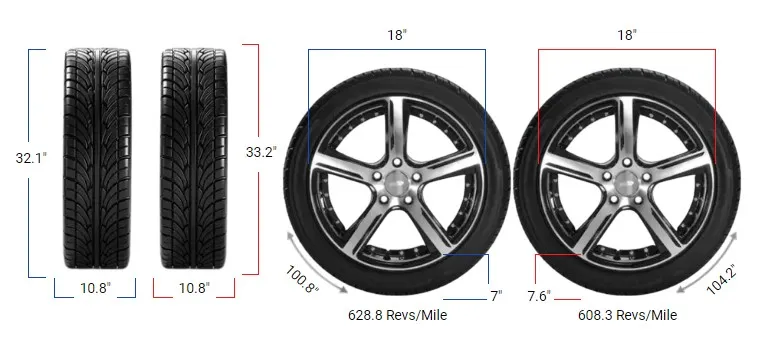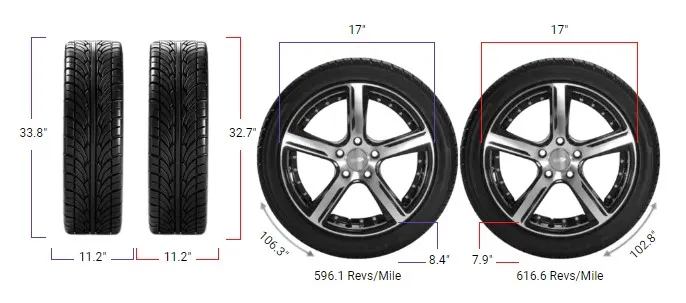Tire Size 275/65r18 vs 265/65r18

Thinking about swapping your 275/65R18 tires for 265/65R18? Let’s dive into the details and explore the impacts of this tire switch.
- Diameter decreases by 0.51 inches resulting in slightly lower ground clearance
- Tire width reduces by 0.39 inches potentially affecting handling and traction
- Sidewall height decreases by 0.26 inches which may impact ride comfort
- Circumference shrinks by 1.61 inches affecting overall tire rotation
- Revolutions per mile increase by 10.2 potentially improving fuel efficiency
- Smaller size may offer better fitment and reduced risk of rubbing

Fitment Guide
Good news for those considering this tire switch – the diameter difference between 275/65R18 and 265/65R18 is only 1.6%, well within the acceptable range of 3%.
This means you can safely make the change without significant alterations to your vehicle or major impacts on its performance.
On-Road Impact
The shift to 265/65R18 tires brings subtle changes to your on-road driving experience. Let’s explore how this switch affects various aspects of your vehicle’s performance:
- Handling: The narrower width of the 265/65R18 tires may result in slightly less grip during cornering, especially in dry conditions. However, the difference is minimal and likely unnoticeable to most drivers.
- Fuel Efficiency: The smaller, lighter 265/65R18 tires could potentially improve fuel economy by a small margin. The reduced rolling resistance and lower weight might contribute to slightly better gas mileage, though the difference would be minimal.
- Ride Comfort: The change in tire size may lead to a marginal improvement in ride comfort. The slightly smaller sidewall of the 265/65R18 (6.78 inches vs. 7.04 inches) could result in a bit less cushioning, but the difference is likely imperceptible to most drivers.
- Speedometer Accuracy: The 1.6% difference in tire diameter will affect your speedometer reading. When your speedometer shows 20 mph, you’ll actually be traveling at 19.68 mph. This small discrepancy is unlikely to cause any significant issues but is worth noting for precise speed monitoring.

Off-Road Impact
For off-road enthusiasts, the switch to 265/65R18 tires brings some considerations:
- Traction: The narrower width of the 265/65R18 tires may provide a slight advantage in loose or muddy conditions, as the reduced footprint can help the tire “cut” through soft surfaces more easily.
- Ground Clearance: The 0.51-inch reduction in overall diameter translates to a minimal loss of ground clearance – about a quarter of an inch. This small change is unlikely to significantly impact your off-road capabilities.
- Wheel Protection: The slightly smaller tire size might offer a bit less protection for your wheels against rocks and obstacles, but the difference is marginal.
Aesthetics & Fitment
The visual difference between 275/65R18 and 265/65R18 tires is subtle:
- Appearance: The 265/65R18 tires will appear slightly narrower and have a marginally smaller overall diameter. This change may give your vehicle a slightly more streamlined look, but the difference is minimal.
- Wheel Well Fitment: The smaller size of the 265/65R18 tires ensures they’ll fit comfortably within your wheel wells, potentially reducing the risk of rubbing or clearance issues.

Durability & Wear
Tire longevity is an important consideration:
- Tread Life: The difference in size is unlikely to have a significant impact on tread wear. However, the slightly smaller contact patch of the 265/65R18 tires might distribute weight more evenly, potentially leading to marginally improved tread life.
- Load Capacity: The narrower 265/65R18 tires may have a slightly lower load capacity. Be sure to check the load rating to ensure it meets your vehicle’s requirements.
What is the Difference Between 275/65r18 and 265/65r18?
The primary distinction between 275/65R18 and 265/65R18 tires lies in their width. The 265/65R18 is 10mm narrower, resulting in a 3.6% decrease in width.
This change affects the tire’s footprint, potentially influencing traction and handling characteristics.
Can I Use 265/65r18 Instead of 275/65r18?
Yes, you can use 265/65r18 instead of 275/65r18. The diameter difference between these two sizes is only 1.6%, which is well within the recommended 3% tolerance.
This means the switch should not significantly affect your vehicle’s performance, speedometer accuracy, or safety.
How Much Taller Is a 275/65r18 Tire Than a 265/65r18?
A 275/65r18 tire is 0.51 inches (13 mm) taller than a 265/65r18 tire. The 275/65r18 has a diameter of 32.07 inches, while the 265/65r18 has a diameter of 31.56 inches.
How Much Wider is a 275/65r18 Tire Than a 265/65r18?
A 275/65r18 tire is 0.39 inches (10 mm) wider than a 265/65r18 tire. The 275/65r18 has a width of 10.83 inches, while the 265/65r18 has a width of 10.43 inches.
275/65r18 vs 265/65r18 Table
This table provides a clear comparison of the two tire sizes and their differences.
| Feature | 275/65R18 | 265/65R18 | Difference |
|---|---|---|---|
| Diameter inches (mm) | 32.07 (814.7) | 31.56 (801.7) | -0.51 (-13) -1.6% |
| Width inches (mm) | 10.83 (275) | 10.43 (265) | -0.39 (-10) -3.6% |
| Circumference inches (mm) | 100.77 (2559.46) | 99.16 (2518.61) | -1.61 (-40.84) -1.6% |
| Sidewall Height inches (mm) | 7.04 (178.75) | 6.78 (172.25) | -0.26 (-6.5) -3.6% |
| Revolutions per mile (km) | 628.78 (390.71) | 638.98 (397.04) | 10.2 (6.34) +1.6% |
| Speedo Reading | 20 mph | 19.68 mph | -0.32 mph |
Our Observation
Switching from 275/65R18 to 265/65R18 tires offers a mix of subtle benefits and minor drawbacks. The narrower width may slightly improve fuel efficiency and off-road performance in soft conditions, while potentially reducing on-road grip marginally.
The small decrease in diameter has a negligible impact on ground clearance and speedometer accuracy. For most drivers, the differences in on-road and off-road performance will be barely noticeable.
The change could be beneficial for those seeking improved fuel economy or a slightly sleeker look, without significantly altering the vehicle’s capabilities. Ultimately, the decision to switch depends on personal preferences and specific driving needs.



